· White Bridges waterfall. Ladoga region. South Karelia. White Bridges waterfall in Karelia
Yukankoski waterfall is considered the highest in the south of Karelia. The nineteen-meter cascade is 8 meters higher than the well-known landmark of the region - the Kivach waterfall. True, Yukankoski is inferior to it in terms of deep water, but it is located in a very picturesque place.
The waterfall is located in a dense forest 10 km from the village of Leppäsilta and 33 km from the city of Pitkäranta. Getting there takes some difficult roads, but the majestic landscapes and magnificent views are worth it.
The waterfall has two names at once. First, Finnish - . It is believed that he got it from the name of the small Finnish village of Yuka, which was located nearby.
Later the Russians named the waterfall White Bridges. This name is associated with the light-colored stone bridges that the Finns once built upstream of the river. Today the bridges are gone, but the name remains. Sometimes the waterfall is called White Pillars, but this is incorrect.
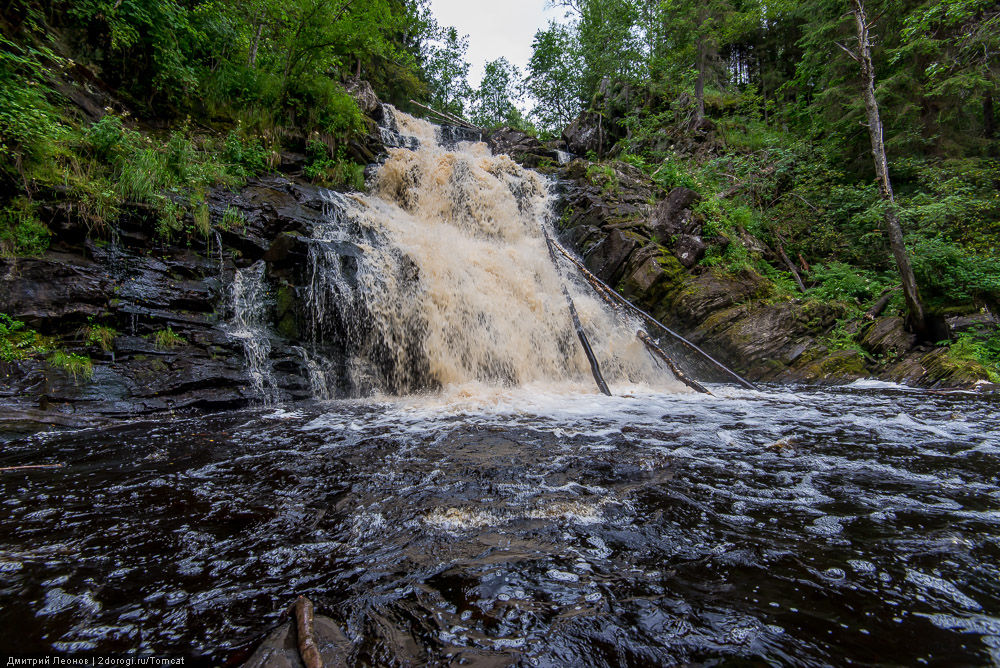
Yukankoski Falls changes its appearance throughout the year.
In spring it is a turbulent, full-flowing stream; peat impurities give it an unusual yellow color. With furious force it falls from a high stone ledge into a foaming and seething cauldron at the foot of the cascade.
In the summer, Jukankoski moderates his temper. The amount of water in it decreases and you can watch how the crystal-clear streams into which the waterfall is divided form a whimsical foamy lace at its foot. There is little water at this time and it quickly warms up, which is taken advantage of by numerous tourists who enthusiastically swim right in the waterfall.
In the fall, Jukankoski begins to gain strength. This process ends in the first frosts, which bind the cascade with thin ice. The power of the water flow is not enough to throw off the ice shell. In the most severe cold weather, the waterfall freezes, the stream is covered with solid ice deposits, in the depths of which water continues to flow.
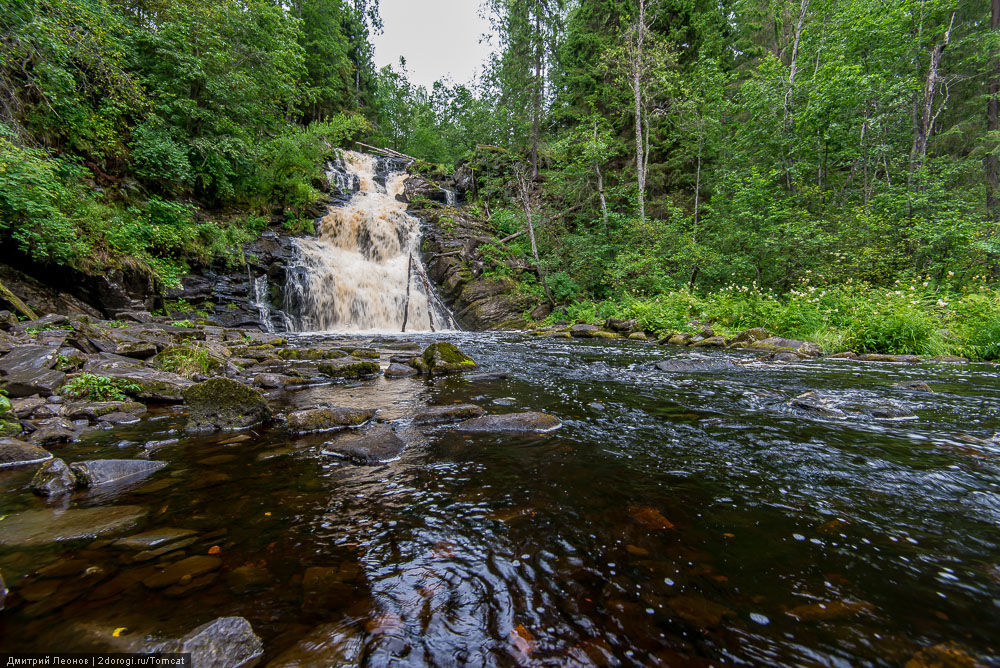
The Kulismajoki River, on which Jukankoski is located, splits into two branches not far from it. A small channel, located opposite the main cascade, flows around a small island and forms another waterfall there. It is called White Bridges - 2. In terms of its power, it is much inferior to its “elder brother”, but no less beautiful. In summer, especially hot, the waterfall can dry up, but in autumn and spring it is quite full of water.
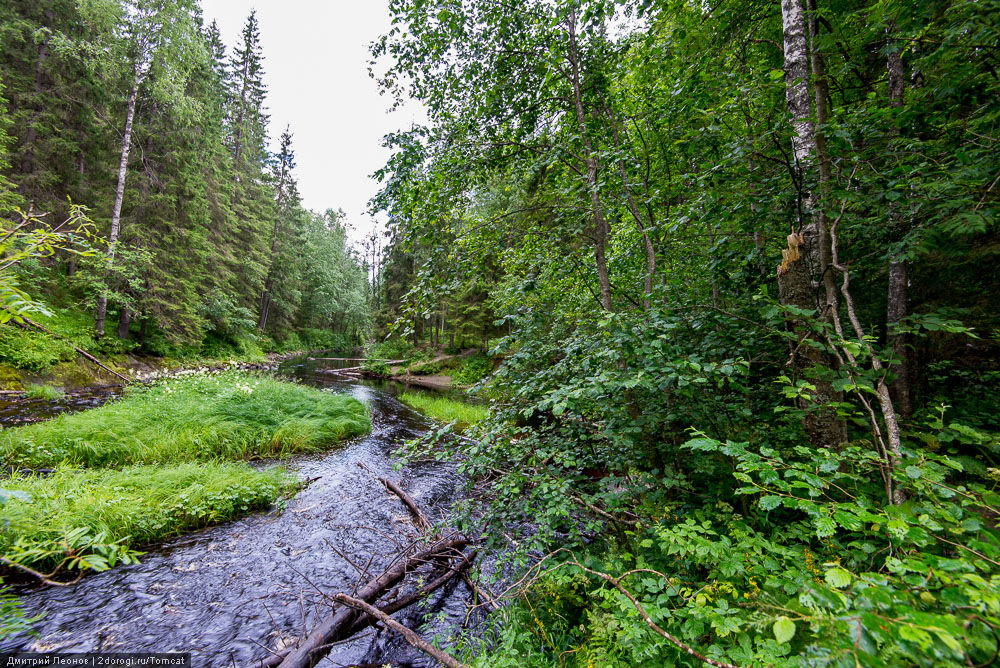
Kulismajoki in the waterfall area.
The surroundings of the waterfall are very picturesque. The beautiful Kulismajoki calmly rolls its clear waters along ancient boulders covered with moss. Its left bank is especially beautiful. It is covered with majestic centuries-old fir trees. Not far from the trail leading to the waterfall is a beautiful clearing, ideal for setting up a small camp. This is not forbidden, provided that tourists keep it clean and do not cause harm to the place, which is unique in its beauty.
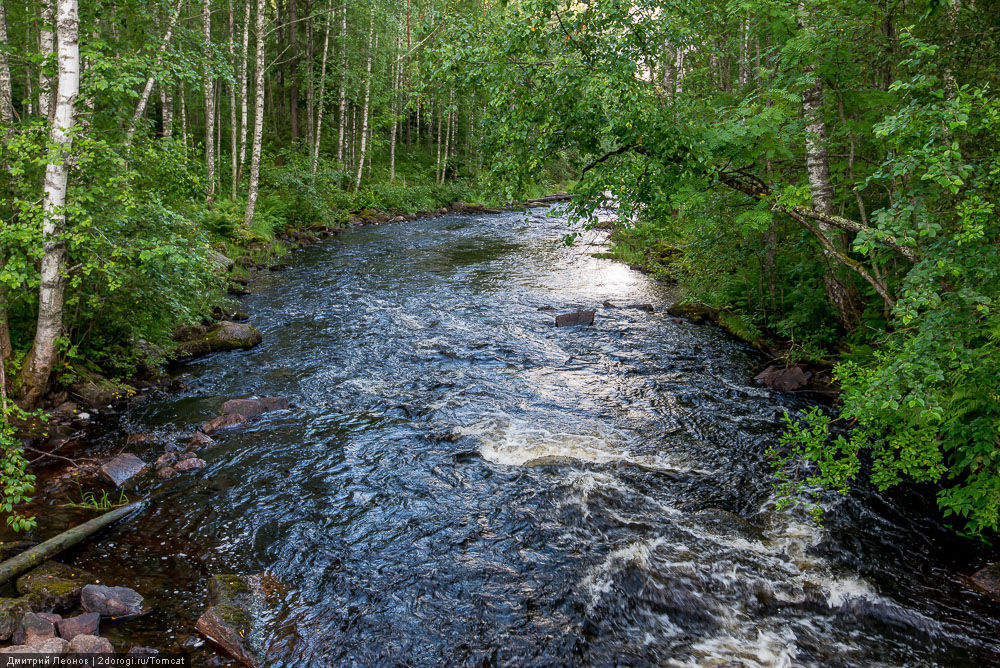
The Kulismajoki River is 3 kilometers below the waterfall.
It must be said that human presence in the vicinity of Yukankoski is minimal. Once upon a time there was a Finnish farm nearby, but today only ruins remain. In these parts there are only hunters, loggers and tourists, the number of which is quite large. During the day, several fairly large people come to admire the beauty of the waterfall. tourist groups. In the vicinity of White Bridges there are wild animals that feel at ease here in the absence of humans. If you encounter them, you need to be especially careful.
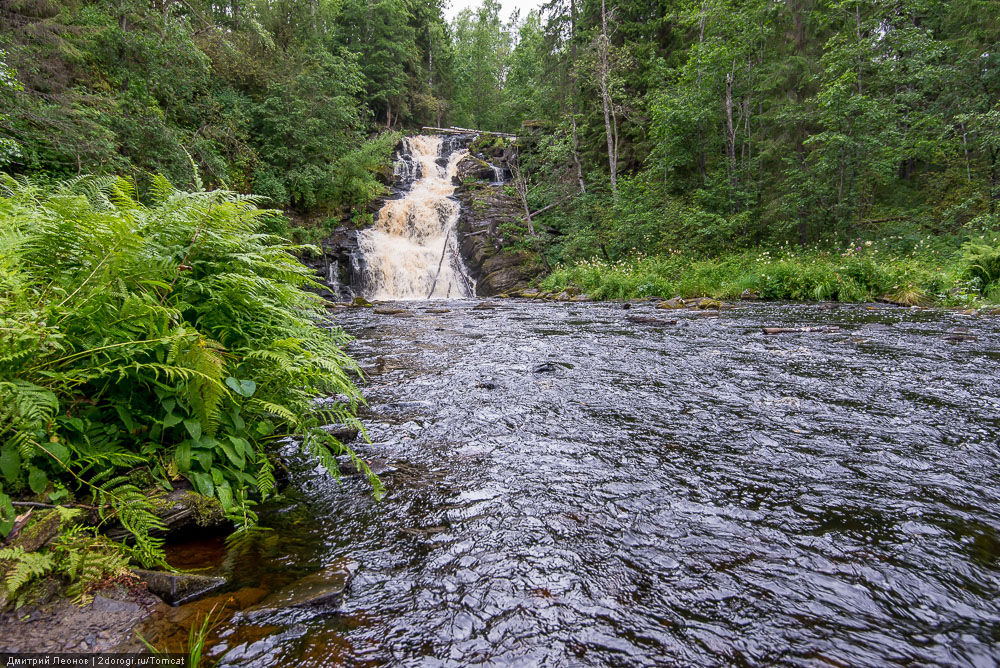
White Bridges Waterfall is beautiful at any time of the year. Despite their relative inaccessibility, every year more and more large quantity travelers strive to get here to enjoy the majestic beauty of nature, untouched by the destructive activities of man.
Yukankoski Falls (White Bridges) - how to get there
There are two roads leading to Yukankoski Falls. They practically do not differ in their road surface. These are strong forest primers, in some places going over rocky areas, in others along clean sand. In normal summer, the roads are passable by almost any car. Problems can only arise in a car with very low ground clearance, and then only in the last kilometer of the journey. In the summer of 2015, almost all types of cars were seen on the road, including the Pitkyaranta Renault Megan taxi. Both paths are well traveled; in the summer and daytime you will meet many fellow travelers. You should be especially careful with oncoming traffic - the forest is crowded in some places, take note of places to pass.
Yukankoski Falls (White Bridges) on the map.
- Yukankoski Falls;
- Parking and tourist sites;
- Fork with a pointer;
- Bridge on the Kulismajoki River. Several years ago it was in a deplorable state, in August 2015 it did not cause any problems;
- Turn off from the highway and rest area;
- Turn onto the road that goes through summer cottages and even in winter is maintained in normal condition;
- The intersection of the Petrozavodsk-Sortavala road and the road to Suoyarvi;
- TNK gas station.
Orange dots - the road to the waterfall from the Petrozavodsk - Sortavala highway.
Blue dots are the road from the highway to Suoryavi.
The next part of the story about the August road trip to Karelia will be short. However, the object I want to talk about deserves mention in a separate post.
The biggest flat The waterfall of Europe is the Rhine Falls on the river of the same name in the Swiss canton of Schaffhausen. Its height is 23 meters. The fact that this waterfall is superior in height and fullness of water is beyond doubt, but there are still a number of discrepancies regarding which other lowland waterfalls are included in the European “top three”. Until relatively recently, it was believed (and indicated in many sources) that the second largest flat waterfall in Europe is located in Karelia on the Suna River - this is the Kivach waterfall, glorified by Gabriel Derzhavin, which has a height of 11 meters. In more modern sources (including the notorious Wikipedia), the Big Janiskengas (Mamanya) waterfall on the Kutsajoki River in Murmansk region. Its height is approximately 20 meters, and in terms of depth it is clearly ahead of Kivach, which the same sources give an honorable third place. In this post we will talk about the waterfall that knocks Kivach out of the top three.
55 kilometers from Sortavala on the A-121 highway in the direction of Petrozavodsk there is an equipped parking lot for motorists to rest. From here begins a dirt road that leads to one of the most majestic natural attractions of southern Karelia - the Yukankoski (White Bridges) waterfall on the Kulismajoki River. The waterfall became widely known only a few years ago, although the Finns once laid a road near it and built bridges across the stormy waterfall. river flow, from which the waterfall received its Russian name. The waterfall is located quite far from highways and populated areas, and the road to it is full of dangers. It’s not always easy to find and pass, so, as always, I’ll tell you how and what you can use to get to this amazing corner of nature.
The dirt road, as already mentioned, starts from the parking lot on the highway. The distance to the waterfall along it is about 12 kilometers. There are several forks in the road that may (or may not!) have homemade Waterfall signs. Although the auto-navigator makes the task of finding the right road to the waterfall easier, it doesn’t make it much easier, so it’s advisable to memorize the road in words: at the first fork after leaving the parking lot, we keep to the right (there is a sign on it, or at least there was one in our presence); we drive about 4 kilometers, past Lake Ruokoyarvi (it will be on the left, by the way, there are places to stop with tents) to the second fork - a good dirt road goes to the left, to the right, to put it mildly, it’s not good - we go to the right along a bad dirt road (there was no sign here ); the third fork is located a little further from the second, at which you need to turn left (there is a sign); then straight ahead, without turning anywhere, several kilometers to a clearing directly next to the waterfall. And, attention, very important point: after the third fork, after a while the road begins to go along uneven terrain, strewn with large and medium-sized, and sometimes very sharp stones. You need to drive very carefully. And God forbid you go on this road in a car with low ground clearance - you will leave there everything that is under the bottom of your car, including the bottom itself (there were precedents). In addition, in the lowlands of the road there are places that are completely washed away in wet weather - you can easily “sit down” there, but it’s a long and long walk to get a tractor (we were lucky, it had not rained for a long time at that time). So you can only get to the waterfall by SUVs, honest crossovers or other cars with normal clearance, or by a product of the domestic automobile industry (I drove a Zhiguli). If you have a sports car, an SUV, a lowered Priora, or some other “puzzler” - drive to the stones, throw it there and stomp on foot. Because it's worth it.
So, early in the morning, we turn up our tent camp near the Ruskeala waterfalls and move towards Petrozavodsk with a stop at the waterfall. While we were winding down, I took this shot of the morning valley and fog over the Tokhmajoki River:
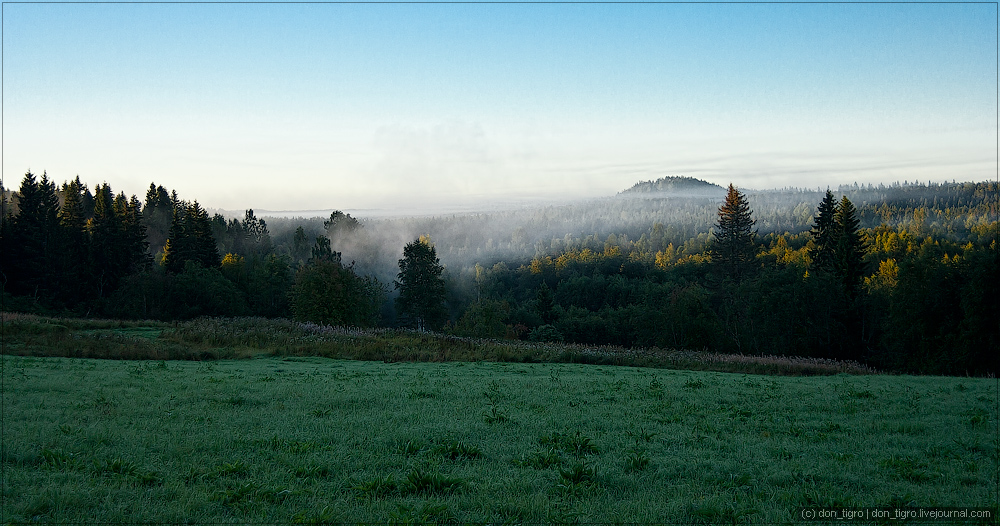
Along the way we made another stop on the shore of the bay. Lake Ladoga.
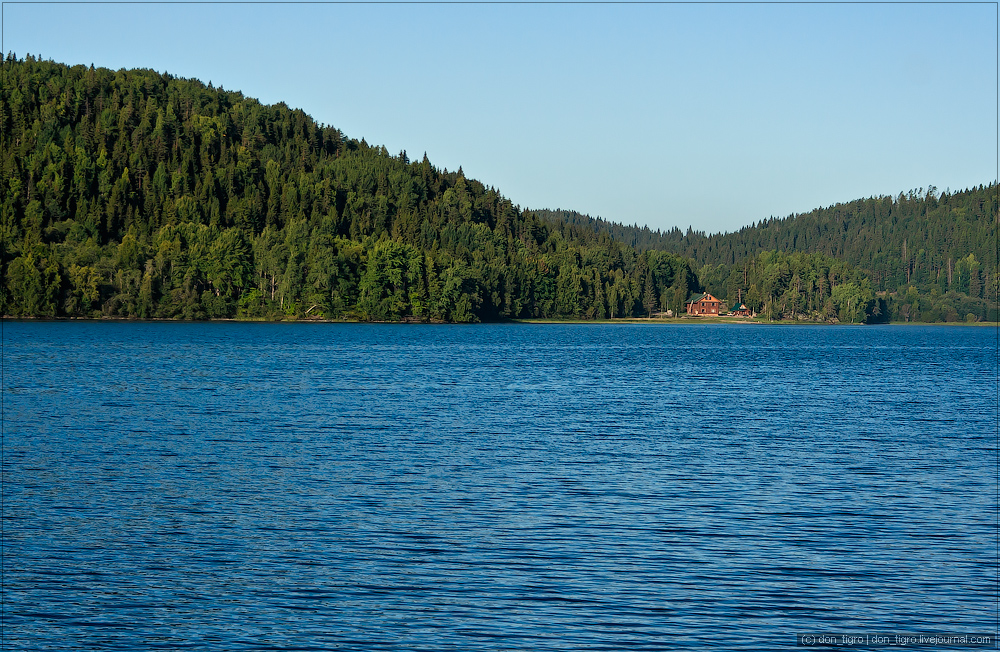
In fact, despite the preparation and arsenal of all kinds of gadgets such as navigators and computers with mobile internet, we didn’t have a clear understanding of how to get to the waterfall. And it’s even possible that we wouldn’t have gotten to it if it weren’t for one episode that happened along the way. At that moment, when we, having already driven a decent distance from the highway, were standing at the second fork in the dirt roads and deciding which way to move next, a hiker suddenly came towards us, almost “in the middle of Karelia.” The tourist turned out to be from St. Petersburg; he came to these parts on his own over the weekend in order to also find this very waterfall. He had the vaguest ideas about the road to the waterfall, that is, gleaned from the Internet, but by the time he came to us, he had already managed to wave away a kilometer from the fork in the “wrong” direction and come back, telling us that the waterfall was there , where he went, no. Of course, we took a friend on board, and subsequently he helped us overcome the rocky sections of the road. Actually, if not for this unexpected meeting, I would hardly have climbed the stones on the road at all, and most likely we would not have reached the waterfall.
So, going down from the clearing down to the river, we find ourselves at the top of the waterfall. Rapids on the Kulismajoki River:
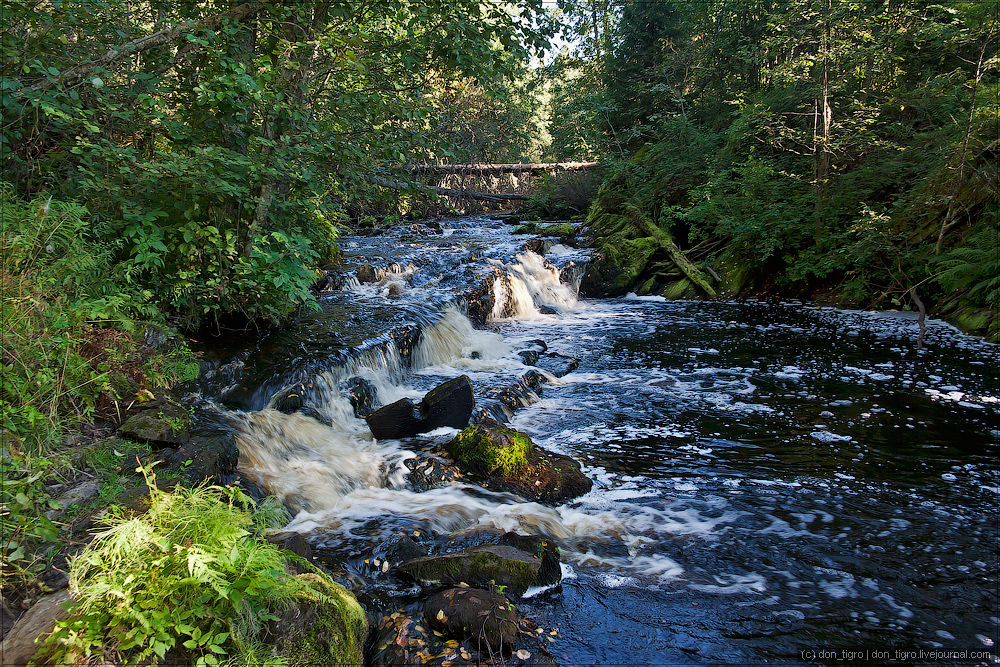
The river water has a brown tint due to the high content of iron compounds. This is what the top of the waterfall looks like. Water falls down from the ledge.
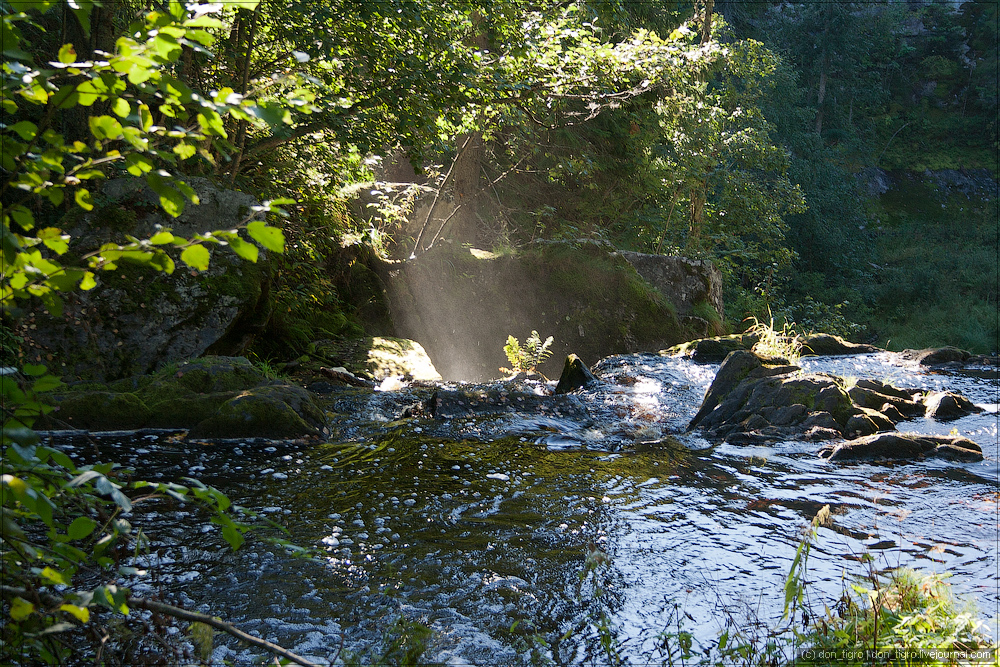
The river in the lower part, after the waterfall, is shallow and rapids.
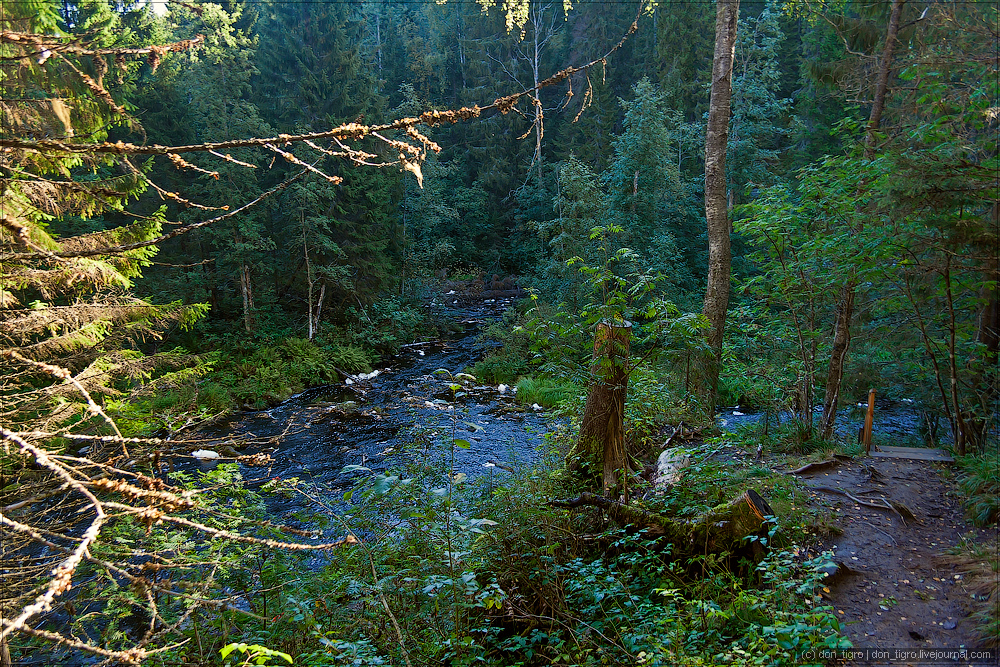
Rapids of Kulismajoki, shooting from a tripod. Using a tree thrown across the river, you can get to the second branch of the river - it seems that there is a waterfall there too. However, we did not dare to check this fact.
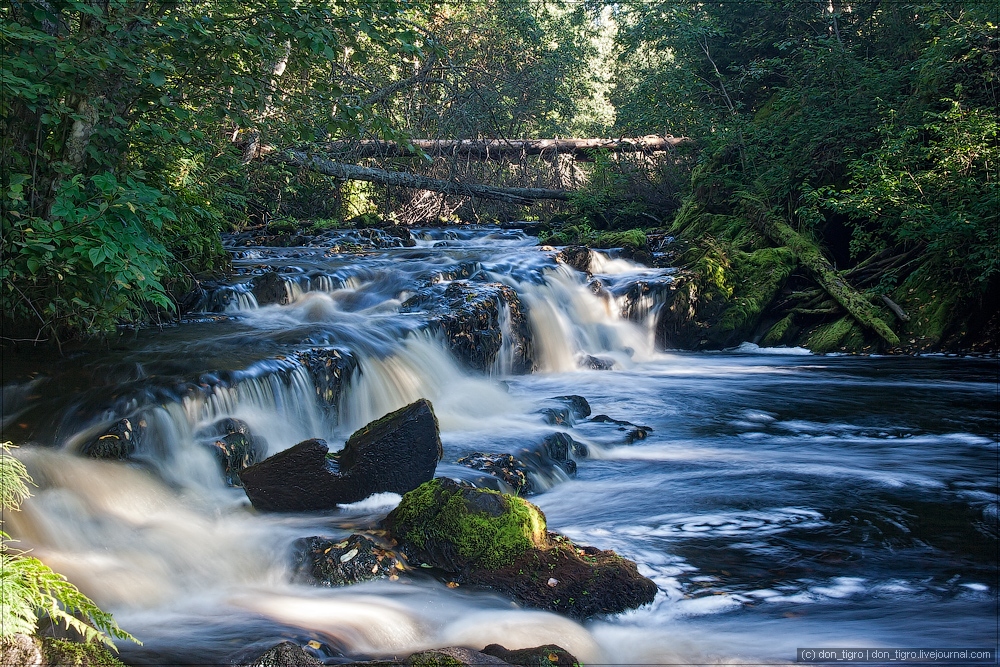
And finally, the view for which it was worth visiting this place. Yukankoski Falls in the morning sun, in all its splendor:
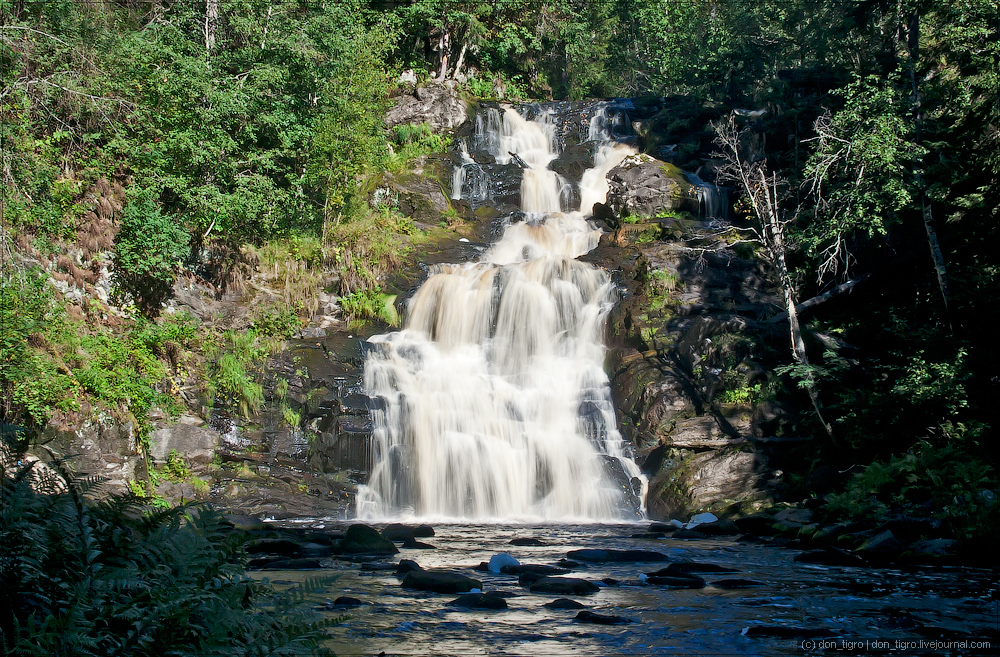
The height of the waterfall is about 17 meters. The waterfall is the highest in southern Karelia and the third highest flat waterfall in Europe. You can look at him endlessly...

The water pressure at the waterfall is not constant and depends on climatic conditions. The maximum pressure is observed in spring. At the end of summer, especially if there has been little rainfall, the river becomes shallow and the pressure is very low - the water can barely trickle over the rocks. We were lucky; at the end of August the spillway was simply gorgeous.
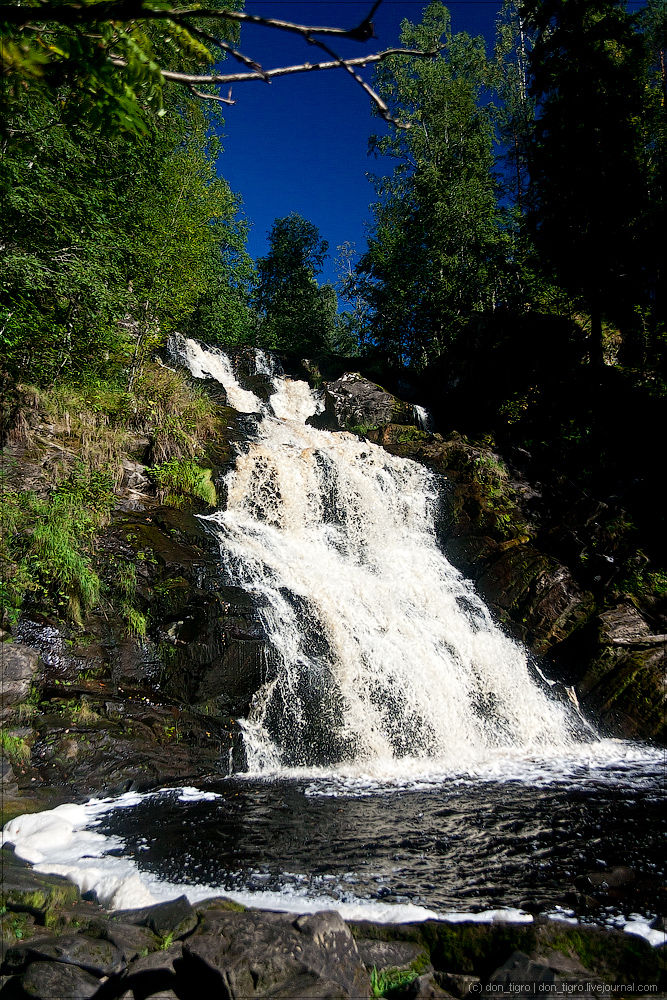
Upper part of the waterfall:
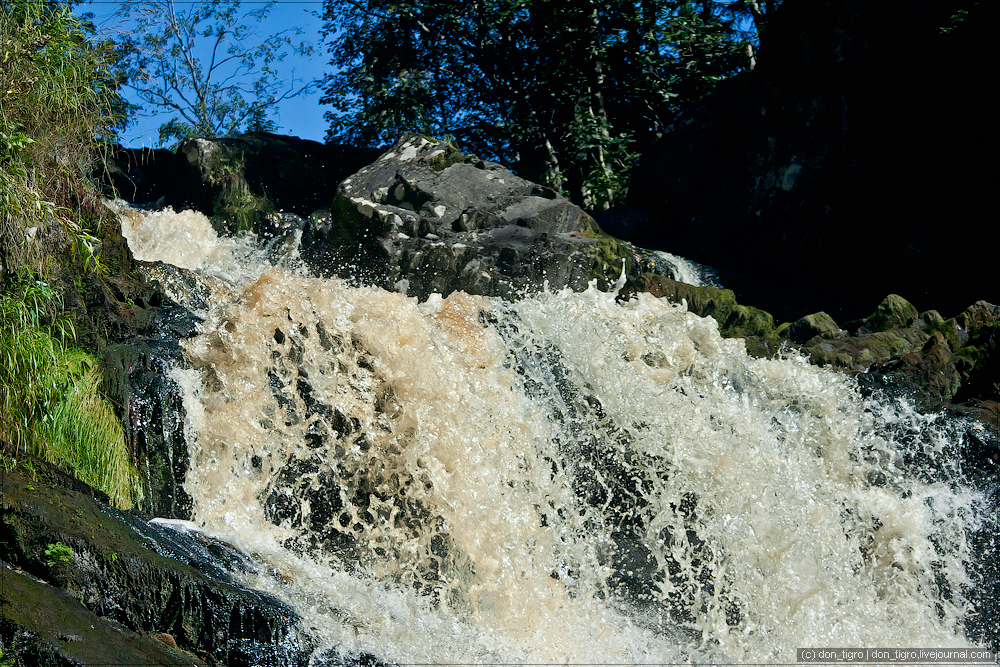
And, for clarity, another photo of a waterfall with a human figure in the frame:
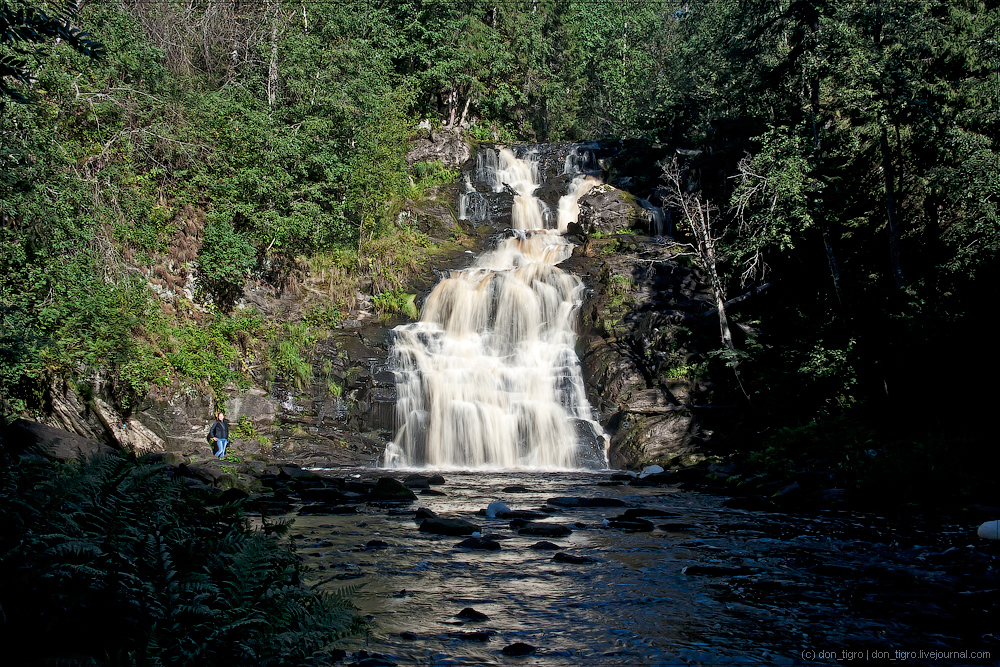
On the Kulismajoki River (aka White Bridges) this is the most big waterfall V . The height of Yukankoski is 17 meters in spring and 19 meters in summer; it is 7 meters higher than famous waterfall Kivach.
Attention, this article often uses Finnish names. Don't break your tongue))
Find Yukankoski waterfall not easy. It's even more difficult to get to it. However, it is worth it, especially in the spring.
During high water in the rivers, Yukankoski It is a powerful thundering stream falling from the height of a six-story building. In summer, on the contrary, waterfall turns into several small graceful streams.
More suitable for a quiet family trip. Yukankoski it can become a real adventure, albeit on a local scale.
How to get to Yukankoski Falls
In the north of Lake Ladoga there is the village of Leppäsilta. We will be guided by it. By the way, you must definitely clarify what to get to Yukankoski Falls Only possible with a four-wheel drive vehicle. And in the spring only in a UAZ, Niva or an equally fierce car.

Look at the map. From Leppäsilta you need to go in the direction of Petrozavodsk, after about three kilometers there will be a rectangular area on the left side of the road. It is marked on the map as "Parking". A dirt road runs away from it at an acute angle to the road (marked in red). It’s easy to get to Lake Ruokojärvi along it - the road is good. Where the arrow is on the map "Cape" you can relax, go fishing and even spend the night in a tent. Further the road gets worse. Please note that you need to drive without turning anywhere.
You won’t be able to drive past the waterfall; the road runs straight into it—a dead end.
Yukankoski Falls coordinates: 61°45′12.4″N 31°24′36.7″E
The distance from Leppäsilta to the waterfall is about 14 kilometers.
Near the waterfall there is a clearing where you can spend the night in a tent. It will be difficult to fall asleep to the sound of water.
There, near the waterfall, you can find the ruins of a Finnish farm. By the way, the farm was called Yukankontu, which in Russian means Yukki Manor - Yukka is a common Finnish name. This is where the name Yukankoski Falls comes from.
A few meters upstream there is a small bridge over the Kulismajoki River. Walking along it you can see another small waterfall.
A trip to it can be an unforgettable adventure!
The calm Kulismayoki River flows in the south of Karelia; its banks, composed of moraine rocks, are low.
But ten kilometers from the city of Leppäsilta, the flow of Kulismajoki, which cannot be classified even as a medium-sized river, is blocked by basalt rocks and it falls down a steep (19 meters high) wall, forming the White Bridges waterfall, which is also called Yukanokoski. It is recognized as the highest water cascade in these places.
The forest plunges you into a fabulous atmosphere: spiky spruce trees, spreading their dark green paws, stepwise climb up a steep slope and only the snow-white trunks of tall birches dilute this green sea. The waterfall is very beautiful, there is something bewitching about it, reminiscent of ancient legends that the Karelian people carefully preserve. Especially old legends come to mind when you are at the bottom of the canyon and you can clearly see the foamy, seething cauldron at the foot of the White Bridges.
The waterfall got its name from the bridges that Finnish builders built in this place where the river falls down. Although the bridges have long ceased to exist and only fragments remain of them, the name has stuck with this picturesque cascade of water.
Beautiful streams of water falling over dark stones are interesting because the appearance of the White Bridges waterfall changes depending on the season. During spring floods, when the river is filled with melt water, Yukanokoski gains power; it roars through the dense forests with a wide, foaming sheet of water. Due to peat impurities, the water turns yellow in spring. During low water, the White Bridges break into blue, crystal clear streams, individually washing the stone ledges. At this time, you can safely stand under the streams of falling water and get great pleasure from swimming in the cool streams. Autumn returns strength to Yukanokoski, it again acquires a majestic appearance, which with the first frost will harden under a snow-white crust of ice. In cold winters, the White Bridges waterfall freezes completely, the ice flows freeze in their desire to fall down, and the water continues to flow under them.

Relaxing by the waterfall
The area around for many kilometers has no traces of human presence, only near the path leading to the White Bridges there is a ruined Finnish farm. These places are visited by lumberjacks and hunters, as many wild animals live in the local forests, among which there are bears and wolf packs. A wooden staircase with railings leads to the waterfall and this structure makes it possible to view Yukanokoski from any point, regardless of height. Tourists chose to install tent camps a beautiful clearing located at the descent into the canyon. In summer, tall grass grows in the clearing. The clearing has a fireplace, a table, benches and a wooden canopy. Near the clearing you can see stone structures, unfortunately already completely destroyed, but they provide an opportunity to appreciate the interesting designs of these buildings and get an idea of the life of the ancient inhabitants of these regions.
It is worth noting that next to the natural attraction it is very clean; there is no garbage left by vacationing tourists.
There are no organized excursions to the White Bridges waterfall yet, but certain groups of tourists take advantage of the opportunity to take a car trip to the White Bridges and back, which is provided by private drivers. Sightseeing is also included in tourist routes carried out on jeeps and ATVs.
How to get to the White Bridges waterfall
Russia, Republic of Karelia, Pitkyaranta district.
You can get to the attraction only by off-road vehicles, since a dirt road that is very old leads to the interesting and beautiful water cascades.
You need to move to the waterfall along the Sortavala Highway, which is laid twenty kilometers from the city of Pitkyaranta. Immediately after the railway bridge, under which the highway is laid, there is a dirt road along which you need to drive to the village of Leppäsyurya. From the village to the White Bridges, drive 10 kilometers along a dirt road.
My friend invited me to Karelia quite recently - in July. Why not agree? We decided to plan a grandiose program with fishing, hunting, and hiking. Summer is made for fun and enjoyment. I flew by plane from Moscow to Petrozavodsk for 5,700 rubles, and my friend and I immediately went by car on a trip to these places. Nature is, of course, stunning. There is something to see! Several days of rest had already passed, and a friend suggested that I go to the White Bridges waterfall. Karelia is rich in all sorts of natural wonders, but this was the first time I had heard such a name. I was intrigued and gave the go-ahead for the trip. The White Bridges waterfall in Karelia has different names: “Pillars”, “Yukankoski”. It is considered the highest in this region: almost nineteen meters.
I'm a fairly experienced tourist and have seen a lot beautiful places, including the famous Niagara, but the beauty of this miracle of nature is difficult to overestimate. It is very difficult to get there on foot, and public transport doesn't come here at all. You can only get there by car, personal or rented. We drove for a long time along unpaved country roads, following barely noticeable signs along the way.
Waterfall "White Pillars". Karelia-2016
We heard from afar by the noise beautiful waterfall"White Bridges". Karelia never ceased to amaze me: foamy streams ran down the rocky rapids, like steps, like the gray beard of an old man. The dense greenery around created the impression of some kind of tropics, as if from the movie “The Jungle Book”.
I was very pleased that the surroundings were clean and tidy, probably due to the fact that travelers rarely get here on their own and mostly only excursion groups or companies with their own cars hang out here.
The approach to the cascade is well equipped with stone, iron and wooden paths with comfortable railings. There is a picnic area nearby, and in the water from June to August you can swim very well, which is what we actually did.
It turns out that our White Pillars waterfall is very popular among guests who come to the republic in groups. Mysterious Karelia - quite developed tourist destination: many people come here for fishing, hunting, camping and just to get some air, and some come to look at such a landmark. I clarified: sightseeing tour costs about 1500 rub. when traveling from Petrozavodsk.
White Bridges Waterfall. How to get there?
For those who want to see the White Bridges waterfall, I will tell you in more detail how to get there. It is located about thirty kilometers from Pitkäranta. From settlement, where you stop, you need to get to the turn to Lake Ruokojärvi. After this, you need to confidently move straight along the dirt road, not paying attention to all sorts of forks that will strenuously try to lead you astray, in particular, to the wide road to the left. The landmark is the lake on the left. If you see one, rest assured that the route is correct. After some time, you will come across an inconspicuous green board, where you can finally see the name of the desired destination.
Beautiful White Waterfall. Karelia and its attractions
I am very glad that I made it to the White Waterfall of Karelia. One of strange names it originated from the small Finnish village of Yukankontu, which translated from the Karelian language means “yucca estate”. The name of the cascade is translated as “yucca threshold”. Another name was given by the Finns, who built white stone bridges across the river here, of which only ruins remain.
A local feature is that the power and color of the cascade changes depending on the time of year. In spring, rivers become fuller due to snow melting. Due to the turbulent streams that carry peat impurities, our stormy miracle turns yellow. In summer, the water is crystal clear and warm, but the flow decreases significantly.
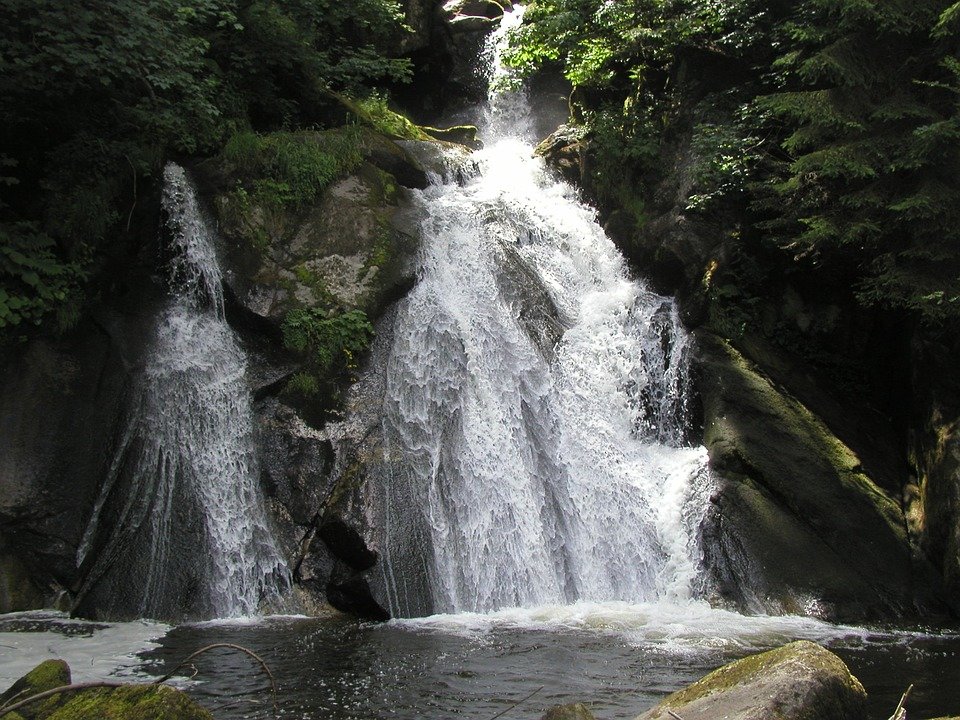
In fact, if you have transport, you can just come here to relax, eat kebab lovingly cooked over a fire, listen to the sound of water, enjoy the clean and fresh air and picturesque nature, have a heart-to-heart talk with friends or loved ones, and take a swim.
